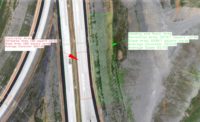In late December, the Federal Aviation Administration published proposed regulations governing the usage of drones in the U.S., triggering a pushback from drone professionals over rules requiring live transmitting of drone locations during operation.
Specifically, the FAA proposes a requirement for remote identification of unmanned aerial systems (UAS), commonly known as drones. All drones used for commercial purposes would have to broadcast their locations at all times while in use. “A UAS that broadcasts or transmits remote identification information would contribute to a cooperative operating environment,” the FAA notes in the regulation. The comment period for the proposed rules ends on March 2.
The rules have already logged thousands of comments from professional and hobbyist drone operators. Construction drone users are particularly attuned to any new regulation, given the rapid expansion of drone flights across the industry.
“Is this new law and regulation a temporary pain? Yes. But will it help our industry be recognized by making the activity in the sky accountable,” says Frank J. Segarra, president and CEO of Connexicore, a drone photography firm based in Milford, Pa., that has documented numerous construction projects.
The additional cost of adding a transponder or identification system to drones remains unsettled. The FAA has not specified what technology would be used to track the drones, only that it will not be the same as the transponder systems used on manned aircraft. While it is expected that manufacturers would incorporate these systems into new drones, there is no plan to grandfather in older drones that lack remote identification systems.
DJI, one of the largest manufacturers of lightweight drones for commercial and hobbyist use, said in a statement that it is reviewing the proposal. “Remote identification will not be successful if the burdens and costs to drone operators are not minimized,” said Brendan Schulman, DJI vice president for policy and legal affairs.
“It is my personal opinion that drone operators or services should not bear the cost of carrying a specific type of remote identification system that broadcasts over the internet,” says Segarra. “This should be the responsibility of all drone manufacturers, not the pilots.”
Commercial drone photographer Lloyd Garden, owner of Drone Promotions in Truckee, Calif., says the proposed rules only make sense if they pertain to controlled airspace. Regularly working in remote areas such as California forests or the Nevada desert, where cellular signals are weak or nonexistent, Garden says a requirement for connectivity during operation could be a problem. “I think people need to know where drones are. But [these rules] are a little restricting for me,” he says.
While the regulations have prompted a strong initial response, a lot is likely to change in drone technology over the next few years before these new regulations take effect, says Mike Winn, CEO of drone-imaging and software firm DroneDeploy. “In the long term, if we’re going have a drone on every construction site, we’re going to need these kinds of regulations on the technology,” he says.
DroneDeploy has not yet filed a formal comment on the proposed regulations with the FAA, but Winn is confident the industry can work with the FAA on a reasonable set of standards. “We are headed to a time when drones will be fully autonomous, and remote identification is a critical step toward that,” he says. DroneDeploy already logs the locations of the drones used by its thousands of customers. Winn does note that the FAA has not fully addressed using drones indoors or in remote areas, both major concerns in construction.
But with the proposed rules still up in the air and a final rule not expected to take effect for several years, there is time to revise and come to a consensus, says Winn. “The whole drone community is looking forward to a remote identification solution, but we have to make sure it’s one that’s not onerous, with no negative privacy implications.”
By Stephanie Loder and Jeff Rubenstone





Post a comment to this article
Report Abusive Comment